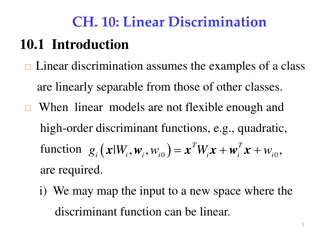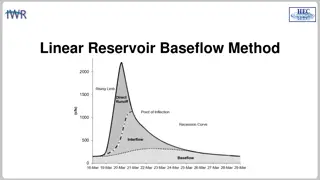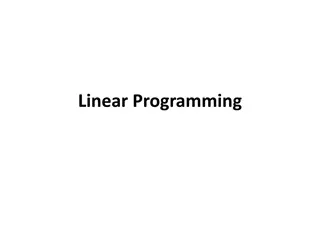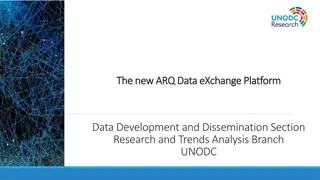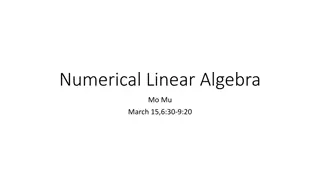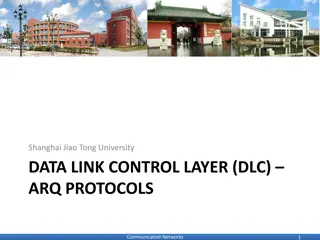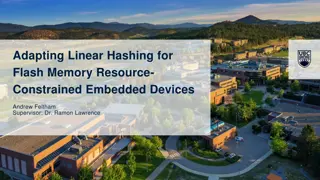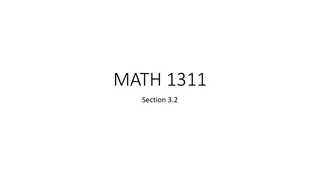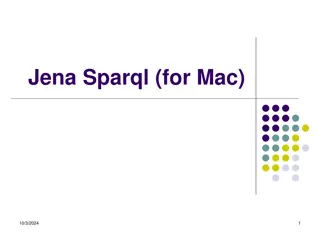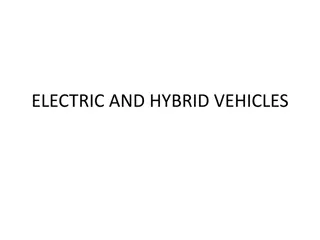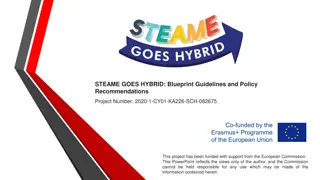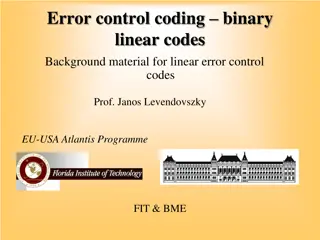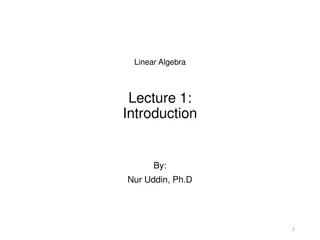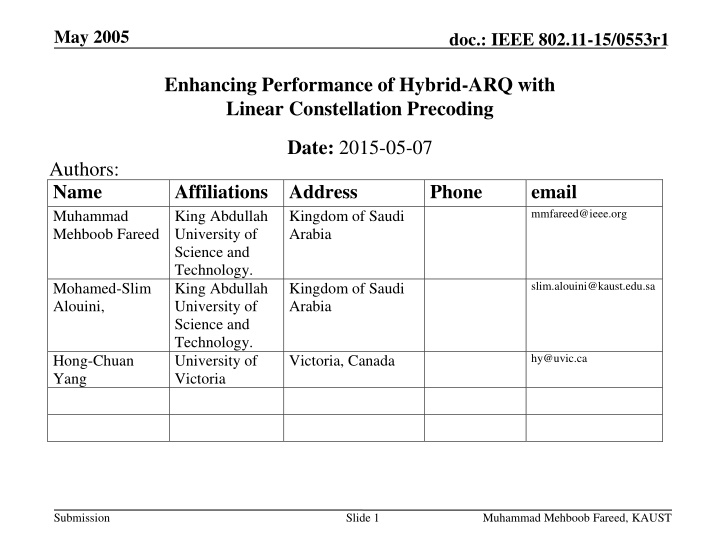
Enhancing Performance of Hybrid-ARQ with Linear Constellation Precoding
Explore a novel hybrid-ARQ scheme using linear constellation precoding that outperforms existing schemes like Code combining and Constellation rearrangement. The scheme shows improved packet error rate performance and transmission throughput across various SNR values. Discover the detailed comparison and benefits in this innovative approach.
Download Presentation

Please find below an Image/Link to download the presentation.
The content on the website is provided AS IS for your information and personal use only. It may not be sold, licensed, or shared on other websites without obtaining consent from the author. If you encounter any issues during the download, it is possible that the publisher has removed the file from their server.
You are allowed to download the files provided on this website for personal or commercial use, subject to the condition that they are used lawfully. All files are the property of their respective owners.
The content on the website is provided AS IS for your information and personal use only. It may not be sold, licensed, or shared on other websites without obtaining consent from the author.
E N D
Presentation Transcript
May 2005 doc.: IEEE 802.11-15/0553r1 Enhancing Performance of Hybrid-ARQ with Linear Constellation Precoding Date: 2015-05-07 Authors: Name Muhammad Mehboob Fareed Affiliations Address King Abdullah University of Science and Technology. King Abdullah University of Science and Technology. University of Victoria Phone email mmfareed@ieee.org Kingdom of Saudi Arabia slim.alouini@kaust.edu.sa Mohamed-Slim Alouini, Kingdom of Saudi Arabia hy@uvic.ca Hong-Chuan Yang Victoria, Canada Submission Slide 1 Muhammad Mehboob Fareed, KAUST
May 2005 doc.: IEEE 802.11-15/0553r1 Agenda Abstract Existing Schemes Code Combining Constellation Rearrangement New Scheme LCP-HARQ Bit Error Rate Comparison Throuhput Comparison Conclusion References Submission Slide 2 Muhammad Mehboob Fareed, KAUST
May 2005 doc.: IEEE 802.11-15/0553r1 Abstract In this work we propose a novel hybrid-ARQ scheme, which outperforms Code combining (CC) and Constellation rearrangement (CoRe) in both packet error rate performance and transmission throughput over a wide range of SNR values. The proposed scheme uses linear constellation precoding (LCP) to construct symbol vectors for transmission and re-transmissions. Submission Slide 3 Muhammad Mehboob Fareed, KAUST
May 2005 doc.: IEEE 802.11-15/0553r1 Code combining (CC)-HARQ [Chase1985] Same information is sent in successive retransmissions and maximal ratio combining (MRC) is done at the receiver to decode the data. Submission Slide 4 Muhammad Mehboob Fareed, KAUST
May 2005 doc.: IEEE 802.11-15/0553r1 Constellation Rearrangement (CoRe) [Wengerter2004] Observation: Different protection levels are offered to different bits in higher order modulations. Example (16-QAM): Two of the four bits in a symbol have a higher probability of error than the other two bits. CoRe: Average the reliability of different bits over successive transmissions by swapping the position and/or negation of the least significant bits (LSB). Submission Slide 5 Muhammad Mehboob Fareed, KAUST
May 2005 doc.: IEEE 802.11-15/0553r1 CoRe (cont.) CoRe Example: Adopted in 3G and 4G communication standard o HSDPA transmission mode of the universal mobile telecommunications systems (UMTS) [3GPP], o WiMax IEEE 802.16m. Submission Slide 6 Muhammad Mehboob Fareed, KAUST
May 2005 doc.: IEEE 802.11-15/0553r1 New Scheme LCP-HARQ A distinct vector is chosen from a pre-constructed codebook for transmission of every B input information bits, and elements of this vector are transmitted one by one in case a NACK is received from the destination. Submission Slide 7 Muhammad Mehboob Fareed, KAUST
May 2005 doc.: IEEE 802.11-15/0553r1 Codebook Construction ? be the set of all possible vectors of length L with Let ? = ?? ?=1 components taken from a conventional N-point QAM constellation. Code book at the transmitter Linear precoding matrix Submission Slide 8 Muhammad Mehboob Fareed, KAUST
May 2005 doc.: IEEE 802.11-15/0553r1 Example Target: 4 bits/transmission No. of vectors (M) = 16 N = 4, L = 2 Pre-coding matrix Target: 6 bits/transmission No. of vectors (M) = 64 N = 4, L = 3 Pre-coding matrix 1 1 1 2 ?1 ?2 ?3 ?1 ?2 ?3 ? =1 2 ? =1 , 1 1 ?1 ?2 ? , ? 2 ?1= ? ??= ? ?? ? ??? ??? ??? ?? ??, ??? ??, ???? ?? ?1= ??= ??= ??? ? Submission Slide 9 Muhammad Mehboob Fareed, KAUST
May 2005 doc.: IEEE 802.11-15/0553r1 Advantage of LCP-HARQ The LCP-ARQ scheme achieves averaging effect with application of LCP. Example: 6 bits (b1b2 b5b6) per transmission ?? ? ?? ? ?? ? 3rd time ?? ?? ?? 1st time b1b2 b3b4 b5b6 = ? 2nd time ? ?? ?= ??,??? ?=? Submission Slide 10 Muhammad Mehboob Fareed, KAUST
May 2005 doc.: IEEE 802.11-15/0553r1 Bit Error Rate Comparison 0 10 CC CoRe LCP-ARQ -1 10 AWGN Channel CC and CoRe 64-QAM LCP-HARQ (N = 4, L = 3) -2 10 BER -3 10 -4 10 0 5 10 15 20 25 SNR [dB] New scheme outperforms CC and CoRe schemes by 6.5 dB and 4.2 dB, respectively, at target BER = 10-3. Submission Slide 11 Muhammad Mehboob Fareed, KAUST
May 2005 doc.: IEEE 802.11-15/0553r1 Bit Error Rate Comparison (cont.) 0 10 CC CoRe LCP-ARQ -1 10 -2 10 Rayleigh Channel CC and CoRe 64-QAM LCP-HARQ (N = 4, L = 3) -3 BER 10 -4 10 -5 10 -6 10 0 5 10 15 20 25 30 SNR [dB] New scheme outperforms CC and CoRe schemes by 5 dB and 2.5 dB, respectively, at a target BER = 10-3. Submission Slide 12 Muhammad Mehboob Fareed, KAUST
May 2005 doc.: IEEE 802.11-15/0553r1 Throughput Comparison Rayleigh Channel CC and CoRe 64-QAM LCP-HARQ (N = 4, L = 3) Throughput ? = where ??= Average number of transmissions per packet. 1 ??, New scheme has better throughput as compared to CC and CoRe for SNR range = 10-25 dB. Submission Slide 13 Muhammad Mehboob Fareed, KAUST
May 2005 doc.: IEEE 802.11-15/0553r1 Conclusion New scheme with ML decoder complexity: M search operations (Same as CC-HARQ and CoRe-HARQ ) Outperforms CC and CoRe schemes by 5 dB and 2.5 dB, respectively, at target BER = 10-3 . Higher throughput as compared to CC and CoRe schemes. Submission Slide 14 Muhammad Mehboob Fareed, KAUST
May 2005 doc.: IEEE 802.11-15/0553r1 References [Chase1985] D. Chase, Code combining a maximum-likelihood decoding approach for combining an arbitrary number of noisy packets, IEEE Trans. Commun., vol. 33, no. 5, pp. 385 393, May 1985. [Wengerter2004] C. Wengerter, A. von Elbwart, and E. Seidel, Constellation rearrangement: Enhancement for multilevel modulation formats and transmit diversity, Wireless Personal Communications, vol. 29, no. 1-2, pp. 35 45, 2004. 3GPP, Universal Mobile Telecommunications System (UMTS);. Multiplexing and Channel Coding (FDD). ETSI, 2002. Panasonic, Enhanced HARQ method with signal constellation rearrangement, in TSG-RAN Working Group 1 Meeting, Las Vegas, USA, February 2001. Submission Slide 15 Muhammad Mehboob Fareed, KAUST
May 2015 doc.: IEEE 802.11-15/0553r1 Straw Poll Do you agree to add to the TG SFD: x.y.z The specification shall include an LCP-ARQ scheme to average the reliability of transmitted bits in M-QAM constellations with M>4 to improve the overall error rate. Submission Slide 16 Muhammad Mehboob Fareed, KAUST

